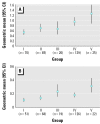Phthalates in indoor dust and their association with building characteristics
- PMID: 16203254
- PMCID: PMC1281287
- DOI: 10.1289/ehp.7809
Phthalates in indoor dust and their association with building characteristics
Abstract
In a recent study of 198 Swedish children with persistent allergic symptoms and 202 controls without such symptoms, we reported associations between the symptoms and the concentrations of n-butyl benzyl phthalate (BBzP) and di(2-ethylhexyl) phthalate (DEHP) in dust taken from the childrens' bedrooms. In the present study we examined associations between the concentrations of different phthalate esters in the dust from these bedrooms and various characteristics of the home. The study focused on BBzP and DEHP because these were the phthalates associated with health complaints. Associations have been examined using parametric and nonparametric tests as well as multiple logistic regression. For both BBzP and DEHP, we found associations between their dust concentrations and the amount of polyvinyl chloride (PVC) used as flooring and wall material in the home. Furthermore, high concentrations of BBzP (above median) were associated with self-reported water leakage in the home, and high concentrations of DEHP were associated with buildings constructed before 1960. Other associations, as well as absence of associations, are reported. Both BBzP and DEHP were found in buildings with neither PVC flooring nor wall covering, consistent with the numerous additional plasticized materials that are anticipated to be present in a typical home. The building characteristics examined in this study cannot serve as complete proxies for these quite varied sources. However, the associations reported here can help identify homes where phthalate concentrations are likely to be elevated and can aid in developing mitigation strategies.
Figures


References
-
- Afshari A, Gunnarsen L, Clausen PA, Hansen V. Emission of phthalates from PVC and other materials. Indoor Air. 2004;14:120–128. - PubMed
-
- Becker K, Seiwert M, Angerer J, Heger W, Koch HM, Nagorka R, et al. DEHP metabolites in urine of children and DEHP in house dust. Int J Hyg Environ Health. 2004;207:409–417. - PubMed
-
- Becker K, Seiwert M, Kaus S, Krause C, Schulz C, Seifert B. 2002. German Environmental Survey 1998 (GerES III): pesticides and other pollutants in house dust. In: Proceedings of the 9th International Conference on Indoor Air Quality and Climate, 30 June–5 July, Monterey, California (Levin H, ed). Santa Cruz, CA:Indoor Air 2002: 883–887.
-
- Bornehag CG, Sundell J, Hagerhed L, Janson S. Pet-keeping in early childhood and airway, nose and skin symptoms later in life. Allergy. 2003;58:939–944. - PubMed
-
- Bornehag CG, Sundell J, Hagerhed-Engman L, Sigsggard T, Janson S, Aberg N, et al. 2005a“Dampness” at home and its association with airway, nose and skin symptoms among 10 851 preschool children in Sweden: a cross sectional study Indoor Air 15suppl 1048–55.10.1111/j.1600–0668.2005.00306.x. - PubMed
Publication types
MeSH terms
Substances
LinkOut - more resources
Full Text Sources

